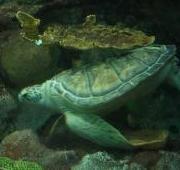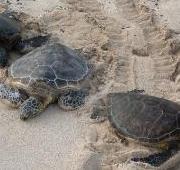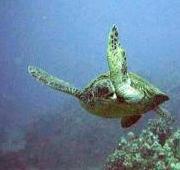 Sea turtles are found in all of the major oceans and smaller seas with the exception of the Arctic Circle as it is generally too cold for sea turtles as they tend to prefer more temperate waters. The bigger species of sea turtle are found more in the Southern Hemisphere in the tropical, warmer waters.
Sea turtles are found in all of the major oceans and smaller seas with the exception of the Arctic Circle as it is generally too cold for sea turtles as they tend to prefer more temperate waters. The bigger species of sea turtle are found more in the Southern Hemisphere in the tropical, warmer waters. There are 7 known species of sea turtle today including the flatback sea turtle which is native to Australia; the green sea turtle which is found all over the world but there are larger populations of the green sea turtle in the Atlantic and Pacific oceans; the hawksbill turtle is a critically endangered species of sea turtle and can be found all over the world; the kemps ridley turtle is the rarest species of sea turtle in the world and is found in the Atlantic ocean and in the Gulf of Mexico; the leatherback sea turtle is the largest species of sea turtle and is the most widely distributed species of sea turtle, found all over the world; the loggerhead sea turtle is known for it's large head and is mainly found in the Atlantic, Indian and Pacific oceans; the olive ridley sea turtle is the smallest species of sea turtle and is generally found in the Indo-Pacific and Atlantic oceans.
There are 7 known species of sea turtle today including the flatback sea turtle which is native to Australia; the green sea turtle which is found all over the world but there are larger populations of the green sea turtle in the Atlantic and Pacific oceans; the hawksbill turtle is a critically endangered species of sea turtle and can be found all over the world; the kemps ridley turtle is the rarest species of sea turtle in the world and is found in the Atlantic ocean and in the Gulf of Mexico; the leatherback sea turtle is the largest species of sea turtle and is the most widely distributed species of sea turtle, found all over the world; the loggerhead sea turtle is known for it's large head and is mainly found in the Atlantic, Indian and Pacific oceans; the olive ridley sea turtle is the smallest species of sea turtle and is generally found in the Indo-Pacific and Atlantic oceans.


The diet of the sea turtle depends on it's particular species. Some species of sea turtle are carnivorous, others are herbivores and some species of sea turtle will eat almost anything. Sea turtles tend to eat sea grasses, shrimp, crabs, fish and jellyfish, depending on what the sea turtle can find and catch.
Sea turtles have the remarkable ability to travel hundreds (in some cases thousands) of miles in order to get between their feeding grounds and their nesting grounds. Most female sea turtles return to the same beach to nest every time and will often emerge from the water just meters away from from where they nested the time before.
Sea turtles will often be able to breed for around 30 years with some species of sea turtle not being able to do so until they are 50 years old. Adult sea turtle have few natural predators besides large sharks and being caught up in human fishing nets meaning that they can live to more than 80 years old. Around 90% of baby sea turtles are eaten by smaller predators like raccoons, sea birds and large fish.
Male and female sea turtles tend to be around the same size. Adult sea turtles vary a great deal in size depending on the species of sea turtle with the smallest sea turtles measuring around 50 cm and largest are nearly 2 m.

